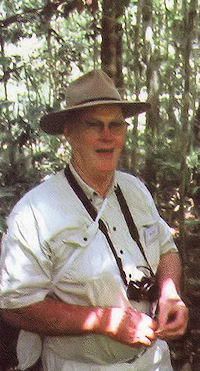 Australasian Regional Annual Meeting Oct. 3, 2009
| |||||||||
It's difficult to point to one event to adequately highlight the October Australasian Regional Meeting held in Ravenshoe. During the day trips, we were guided through World Heritage rainforests containing 1,000 tree species, the most ancient of which are the conifers that have grown there for 200 million years. The conifers where we stood represent around the 1 millionth generation—if you take 200 years as their generation interval. Records of these trees are found in fossils. This is the only place on the planet where a continuous line of evolution is to be found. these conifers are surrounded by their evolutionary descendants, the hardwoods, flowering plants that evolved around 135 million years ago. In the schlerophyll forests around the rainforests are eucalypts which evolved 35 million years ago and acacias which evolved 25 million years ago. These flowering trees now spread throughout the entire Australian continent. Their survival as a continuous line resulted because Australia has not been subjected to glaciation events as most of the northern hemisphere has experienced. The area has also had continuous high rainfall, due in the latter period to their progressive elevation which draws high precipitation from the Pacific Ocean—and the area is still rising—truly the Garden of Eden for trees species. The evening Keynote Addresses took us from the past into a glimpse of the future. Some have described the meeting as one of the most informative wood-focused meeting they have attended 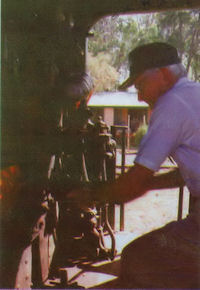 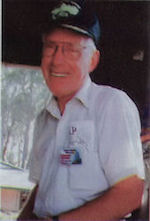 This is a rare photograph of Alan Curtis 'throwing wood into the raging fire' on our locomotive tour—and what's more, he was laughing about it. You'll never again witness such abandon. I think he actually amazed himself that he could do such a thing. One thing is for sure, we were warmly appreciated and cared for by the people of Ravenshoe who made our stay as enjoyable as possible, and we sere included in their celebration of the Torimba Festival of the Forest. Of the 39 registrations we had members from the US, New Zealand, Western Australia, Tasmania, Victoria, New South Wales and Queensland. It was not a short journey for any of us. South east Queensland members travelled over 4,000 km on their round trip. Despite the distance we had over 250 auction items which netted around $2,400 for IWCS. It was also pleasing that around half of the attendees took the opportunity to go on the pre and post tour trips. On the first outing, the 350 metre long Mamu rainforest canopy walk introduced members to the wet tropical rainforest as they meandered through rainforest from ground level up to canopy level—all the time being on 2.5 kim of well-formed paths. 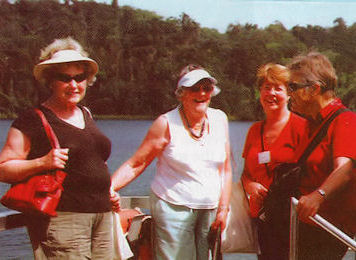 Margaret Gratte, Eve Small, Lalleen Broadbent, and Esther Dennis relax on the front deck during the Lake Barrine cruise. A definite highlight was Reg Lockyer's guided walk through the Charmillin Creek forest. Reg started his rainforest description with the 40,000 year presence of the hunter-gatherer Aboriginals and their influence on the rainforests, as well as his generations contribution to diversity, plus identifying many species and placing them in the context of his lifelong experiences as a 'caretaker-forester' of these areas. In the evening Reg presented the first Keynote Address and continuesd to share his experiences and opinions about human intrusion and impact on the rainforest and the future implications for the rainforests. |
Another highlight was the presentationby Dr Janice Lough, from the Australian Institute of Marine Science, Townsville, who was an author of the 2007 United Nations Scientific Expert Group Report on Climate Change and Susstainable Development. Janice presented a wonderful outline of her involvement in, and results from coral and tree rings research which has progressively revealed details of our past climate and the effects of agriculture and habitation on the Great Barrier Reef. Their work is proving what has previously been considered impossible—that growth rings from hardwood species can be used as a measure of past climatic conditions. Yet another highlight was Matt Bradford from CSIRO Tropical Forests Research Centre, Atherton who guided us through the CSIRO's Arboretum at Atherton. This was followed by his very interesting Keynote Address where Matt outlined studies of tropical rainforest tree responses to catastrophic events like cyclones and fire, as well as studies of seasonal variations in fruiting patterns, and how trees react to climate changes. The results were very thought provoking and defhinitely not what many would have thought was so. 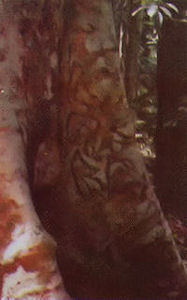 Aboriginal carving on an 800 year-old black walnut (Endiandra palmerstonii). Another highlight was the fourth Keynote Address given by Nigel Tucker, Director of BioTropica Australia Pty Ltd., who spoke about the biological diversity in tropical rainforests and the complex interactions within those ecosystems over time—particularly in the last 100 years whiloe we have gone down the track of 'forestry stewardship'. Nigel's dynamic presentation outlined why Australia's tropical rainforests are worthy of their World Heritage listing. The reasons include:
This is a pretty impressive list which places the area as one of the most important areas for conservation in Australia. Beginning in 1982 a group, which now numbers around 600, are planting trees to enhance future biodiversity and consider: "Tree planting is an act of faith in our collective future". The theme of the meeting was Looking Back—Looking Forward, and it is anticipated that a combined report of these Keynote Addresses will be made available sometime in the future. The organising committee thank all those who participated. |
|
|
